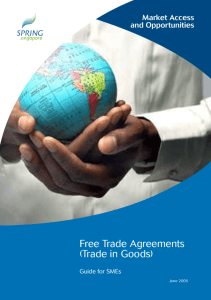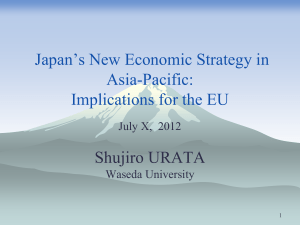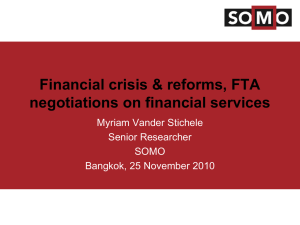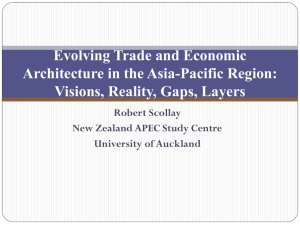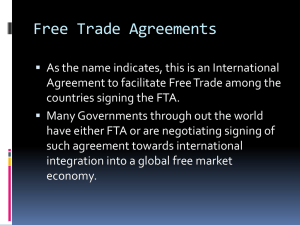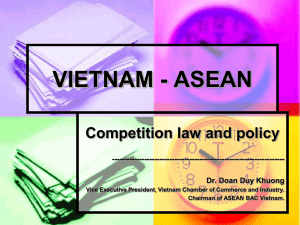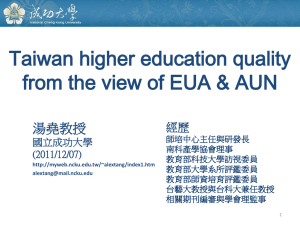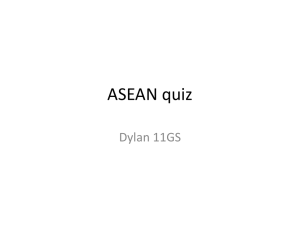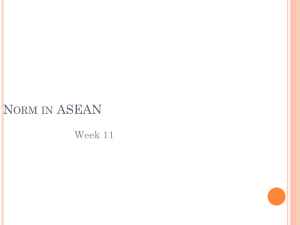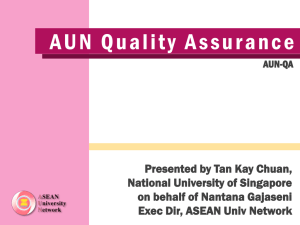Country Paper Presentation and Discussion _Veitnam
advertisement
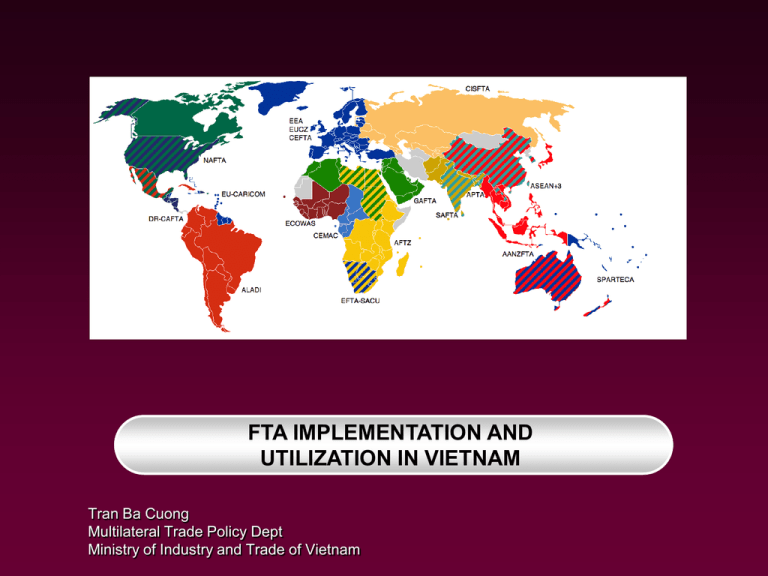
FTA IMPLEMENTATION AND UTILIZATION IN VIETNAM Tran Ba Cuong Multilateral Trade Policy Dept Ministry of Industry and Trade of Vietnam Contents Overview of Vietnam’s FTA SMEs and implementation of FTA Vietnam’s Schedule under ATIGA FTA utilization in Vietnam Enhancement of Utilization Impact of FTAs to domestic Trade Policy Why FTA? 1. Political engine √ √ 2. Not losing export competitiveness advantage or “domino” effects due to FTAs √ √ 3. Tightened the supply of material resources √ X 4. Enhancing bilateral cooperation to promote trade and investment √ X 5. The failure of the multilateral trading system √ √ Overview of Vietnam’s FTAs Viet Nam entered into CEPT/AFTA in 1996 ASEAN finalised CEPT/AFTA in 2003. Viet Nam completed in 2006. In-depth integration by the establishment of ASEAN Economic Community (AEC) in 2015; ASEAN commenced negotiation with China in 2002, with Japan and India in 2003; ASEAN started negotiations with Korea in 2004 Viet Nam completed it’s first FTA with Japan in 2008 ASEAN completed FTA negotiation with Australia and New Zealand in 2009, started implementation in 2010; ASEAN completed FTA with India in 2011 FTAs by Vietnam FTAs concluded/ implemented 1. 2. 3. 4. 5. 6. 7. 8. ASEAN Free Trade Agreement (1996) ASEAN – China Free Trade Agreement (2004) ASEAN – Korea Free Trade Agreement (2006) ASEAN – Japan Comprehensive Economic Partnership Agreement (2008) Vietnam – Japan Economic Partnership Agreement (VJEPA) (2009) ASEAN – Australia and New Zealand Free Trade Agreement (2010) ASEAN – India Free Trade Agreement (2010) Vietnam – Chile Free Trade Agreement (VCFTA) (2012) (not yet implemented) Current negotiating: 1. Trans-Pacific Partnership Agreement (Round 13-San Diego, USA) 2. Vietnam-EFTA Free Trade Agreement (Round 1-Vietnam) 3. Vietnam-EU Free Trade Agreement (to be negotiated soon) Vietnam’s commitments under FTAs Partner ATIGA ACFTA AKFTA AI FTA AJCEP AANZFTA ASEAN-6 2003 2010 2010 2013 2012 2015 Vietnam 2006 2015 2016 2018 2017 2018/2020 CLM 2008/ 2010 2015 2018 2018 2017 2018/2020 20 18 16 14 12 10 8 6 4 2 0 MFN ACFTA AKFTA AJCEP Year of Implementation 23 20 21 20 18 20 15 20 10 20 08 20 07 20 06 20 05 AFTA 20 Average Tariff Tariff Reduction Schedule under FTAs Opportunities for SMEs in the region Trade in Goods: a sharp drop in tariffs would provide a major opportunity for Vietnamese businesses to jump into Members’ markets Tourism opportunity: MICE tourism opportunities are particularly large and hopefully countries that have the most experience in this area such as Thailand and Singapore will render their assistance to those with weak MICE experience recent examples of this are Thailand with Vietnam and also some talk in Thailand about rendering assistance in Laos and possibly Cambodia. Internationalization of health care under the AEC: it offers potentials for the free-flow of health services, etc. in the region. Recent examples here were noted in the Bangkok Post in mid-March which noted programs by Thailand's largest medical service BGH and other Thai hospital groups to step-up the pace of mergers and acquistions and joint ventures in other AEC countries to help give them a better platform to better take care of developing AEC opportunities. Main barriers to promote SMEs in the regional and global supply chain Limited understanding of FTA commitments and hardly taking advantage of all the benefits contained in an FTA, such as preferential tariffs, rules of origin, easier market access and other business opportunities Limited information to locate/analyse markets Shortage of working capital to finance exports Inability to contact potential overseas customers Lack of managerial time, skills and knowledge Challenges to SMEs 1. Burdensome Rules of Origin Regimes: -Value added rule is simple in principle but difficult to comply with: The import content (from non-ASEAN sources) of exports is high, making it difficult to comply with the 40% VA rule. Further, countries with low labor costs find it more difficult to comply with a given VA requirement than high labor cost countries. The VA rule is also vulnerable to exchange rate fluctuations that affect imported input costs. -High administrative cost of compliance to prove origin: computation of costs, invoicing, and other documentation demands inherent in VA rules are complex, especially for SMEs from Vietnam and other developing economies. These problems are particularly acute for SMEs and firms with time-sensitive products 2. Challenge of Multiple and Overlapping Free Trade Agreements and the Noodle Bowl - the multiple and divergent ROOs that give rise to the noodle bowl effect. Divergent ROOs across FTAs lead to fragmented rather than integrated regional markets, added administrative costs for traders and customs officials and production costs for producers, and low FTA utilization rates. Awareness of SMEs, industry associations on the details of ASEAN FTA Not aware much of the rules of origin Application procedures, supporting documents (required to obtain the C/O) create some burdensome, take time and discourage our exporters to apply for a preference Firms, though understand their own production process, fail to adapt it to the ROO Failure of updating the Schedule of tariff reduction year by year Failure of updating the NTB, NTM imposed by importing Parties Goods Schedule of Vietnam under ATIGA Vietnam’s ATIGA/AFTA Tariff Reduction Schedule from 2005 to 2013 Year 2005 2006 2007 2008 2009 2010 2011 2012 2013 Total number of tariff lines 10689 10689 10689 10689 10689 10689 10689 10689 10689 IL 10455 10455 10455 10455 10455 10455 10455 10455 10455 0 - 5% 8496 10256 10285 10296 10054 10059 10072 10069 10097 0% 3277 5447 5478 5511 5488 5488 5488 5488 5491 GE 234 234 234 234 234 234 234 234 234 Source: Ministry of Industry and Trade Based on HS 2007 General Exceptions List, Temporary Exclusion List under ATIGA Status General Exceptions List Commodities Poppy seeds, explosives, retreaded or used tyres, tobacco and cigar(*), municipal waste, clinical waste and sewage sludge Temporary Exclusion List Sensitive products Transferred to IL Transferred to IL (*)Note: - Petroleum products have been taken out of GEL and put into IL from 2012 and it will be phased out completely by 2024. - Tobacco and cigar are supposed to be taken out of GEL from 2015 and subject to negotiation with ASEAN Member States. Source: Ministry of Industry and Trade Utilization of AFTA – Form D Year 2003 2004 2005 2006 2007 2008 2009 Form D NA NA 305.7 450.2 733.5 1,305.6 995.9 Utilization rate NA NA 6.07% 7.10% 9.41% 12.76% 11.41% Source: Ministry of Industry and Trade Utilization of AJCEP Year 2009 Total export value (bil USD) 57.10 Export to Japan (bil USD) Export to Japan/total export (%) Export by CO Form AJ (bil USD) Utilization rate of Form AJ 6.29 11.02% 1.7 27.81% Source: Ministry of Industry and Trade Utilization of specific goods under AJCEP No 1 2 3 4 5 6 7 8 9 Description Precious stone Plastic and Plastic products Fishery Footware Chemicals and Chemical product Textile and Apparels Confectionary and cereal products Bamboo products and mats Vegetable and Fruits Utilization rate Export to Japan Form AJ value of Form AJ 41,141,298.00 34,999,695.23 85.07% 193,284,113.00 760,725,464.00 122,473,697.00 150,017,947.46 534,340,481.43 81,540,903.08 77.62% 70.24% 66.58% 43,714,835.00 954,075,543.00 22,277,230.29 457,512,255.08 50.96% 47.95% 21,283,182.00 9,299,725.35 43.70% 26,227,912.00 31,878,215.00 10,978,701.87 13,106,712.94 41.86% 41.11% Source: Ministry of Industry and Trade Reasons of low utilization of Form D The goods exported to ASEAN not necessary to use CO Form D are at high value (i.e. coal, crude oil), around 50% of export value to ASEAN countries. Some exporters are still familiar to the RVC (40%) criteria and know nothing about the existence of CTC or SP rule. Goods fail to meet the ATIGA rules of origin. High administrative cost of compliance to prove origin Divergent ROOs across FTAs lead to fragmented rather than integrated regional markets, added administrative costs for traders and customs officials and production costs for producers, and low FTA utilization rates. Not aware much about how to apply the rules of origin to the products Enhance the utilization of the FTAs Fully understand the tariff reduction schedule and continuously update it on a yearly basis ensure the best bargain with importers for the sales of goods. Try the best to use the originating materials in the FTA region for the purpose of accumulation Participate into the supply chain in the region for easy access to the distribution channel and market of the FTA partners. Develop supporting industries to supply the locally produced materials, spareparts, accessories, components to the local industries for the purpose of increasing the value added of domestic goods so they can easily meet the requirement of the FTA rules of origin. Deliver disseminations and technical support programs to assist the exporters/manufacturers and associations further understand how the FTAs work so they can utilize the provisions under such FTA agreements efficiently. Find the reason why the utilization is low for each industry, sector, type of enterprises/manufacturers (i.e. domestic or FDI enterprises). From these findings, recommend solutions for the policy makers, manufacturers to improve the utilization rate. Enhancement of Investment and industrial competitive edge Pay more attention to education and training development to create a good human resources. Develop the supporting industries: Continue developing the infrastructure, especially the electricity, highway road and deep sea port. Simplify the administrative procedures for investment licensing. Remove the restrictions to foreign investors appropriately and in conformity with Vietnam’s commitments to WTO and FTAs. Continue amending laws and regulations on foreign investment to create a facilitative, transparent, and predictable environment for investors and in conformity with Vietnam’s commitment to WTO and FTAs. Impact of ASEAN FTA on the trade policy development Vietnam has issued many legal enactments to implement its commitments under ASEAN FTAs. Furthermore, to facilitate the trade, Vietnam also removes some restrictions, requirements on investment, trade in goods and simplify the procedures for the customs. The following areas are mostly impacted by ASEAN FTAs in Vietnam: Rules of Origin; Tariff liberalization; Customs procedures; SPS; TBT; Standards and technical regulations. Conclusions FTA’s Impacts will be more significant Diversified export structure is a determinant factor for gaining benefits from FTAs Non-tariff measures, trade facilitation, trade balanced growth should be reviewed regularly to increase the utilization of the FTAs. There is a necessity to careful assess the benefits of a future FTA, taking into account all elements involved. FTA implementation and impact assessment should be conducted on regular basis to timely undertake necessary measures.
